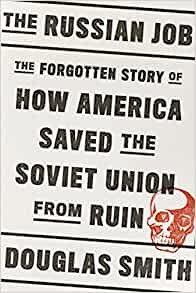Review by Renee M. Earle
 The Russian Job: The Forgotten Story of How America Saved the Soviet Union from Ruin
The Russian Job: The Forgotten Story of How America Saved the Soviet Union from Ruin
by Douglas Smith
Farrar, Straus and Giroux,
November 2019
In this gripping chronicle of the 1920-1923 Russia famine and American efforts to save the starving through the American Relief Administration (ARA), Douglas Smith succeeds in bringing the reader closer to understanding the apocalyptic conditions of Communist Russia at that time. Through pictures, letters and other archival material, he tells a story at once grisly in its depiction of dehumanizing despair that led to suicide, indiscriminate murder, and cannibalism but also uplifting as he introduces the work of Herbert Hoover and the men of the ARA who themselves risked health and life itself to save millions in the remotest regions of Communist Russia.
The story unfolds against the backdrop of persistent political calculations and suspicions on the part of both the West and Communist Russia. The “Red Scare” was in full swing in the U.S. as radical actions killed Americans. Communist leaders were unrelenting in their ruthless maneuvers and missteps as they tried to prevent access to the Russian people by what they perceived as a “Trojan Horse” designed to bring down their new government under the guise of famine relief. Meanwhile, debates among Americans and Western allies centered on whether official recognition of the new Soviet state would moderate or encourage the Bolsheviks.
In 1921, 30 million people in Communist Russia faced starvation. They froze, were lice infested, and diseased. Whole villages disappeared. Nevertheless, the Bolshevik Government often hesitated in sending relief in its drive to stay in power and bring about a new international social order. Smith shows that even Maxim Gorky’s appeal to “humanitarians of the world” was a reluctant appeal.
Smith’s “forgotten story” begins with a recap of Herbert Hoover’s tremendous efforts in establishing “WWI’s Marshall Plan,” reaching not only allied countries but also defeated Germany and Austria-Hungary, in all, 32 countries. Based on purely humanitarian reasons, Hoover now championed unofficial relief for the starving under the Bolsheviks, whom he vehemently opposed politically.
Smith introduces an engrossing list of characters, leaders of the in-country ARA relief efforts, varied in their backgrounds, alternating during their assignments between incapacitating recoil at the horrors they witnessed and optimism for what the U.S. action might accomplish in bringing the two countries closer together. Their personal stories brilliantly illuminate the conditions and events related.
Given the utter devastation of Soviet Russia after years of wars and political mismanagement, the ARA men soon encountered and promoted “mission creep.” In addition to feeding the hungry, they assisted teachers, scientists, and artists, built infrastructure, and delivered clothing and medicines. They traveled by boat, train, horseback, Cadillacs, and sleighs. The inhospitable Russian climate was as much the enemy as broken-down railways and barely visible roads.
At the same time, many ARA men found the magic, mystery, and tragedy of Russia compelling. Amid the misery, culture prevailed. They attended performances and fell in love with Russian women.
Hopes that the ARA’s efforts would leave lasting proof of U.S. support for the Russian people and that Russia would quickly develop economically and politically proved illusory, however. Lessons learned were nowhere to be found in the Soviet response to famine in the 1930’s. When the ARA ended its mission in 1923, immediately and methodically, the erasing began. Soviet Cold War textbooks dutifully characterized the relief efforts as a spy ring organized to bring down the Communist state.
Similarly, decades later, despite “perestroika” and “glasnost,” U.S. expectations that Russia would quickly and smoothly join the Western nations were unrealistic, and our policies wavered accordingly. Subsequent disappointments notwithstanding, the deep admiration and gratitude shown the “Aravtsy” by the people they encountered in the 1920’s leave a glimmer of hope. As in the early 1990’s, when I often heard Russians express pride at the new partnership between Russia and the United States, between “two great empires who could understand each other,” the possibilities of another, future reset remain. These possibilities make Smith’s riveting account all the more important today. He ends by reminding us of America’s good fortune – and its ability to do good.![]()

